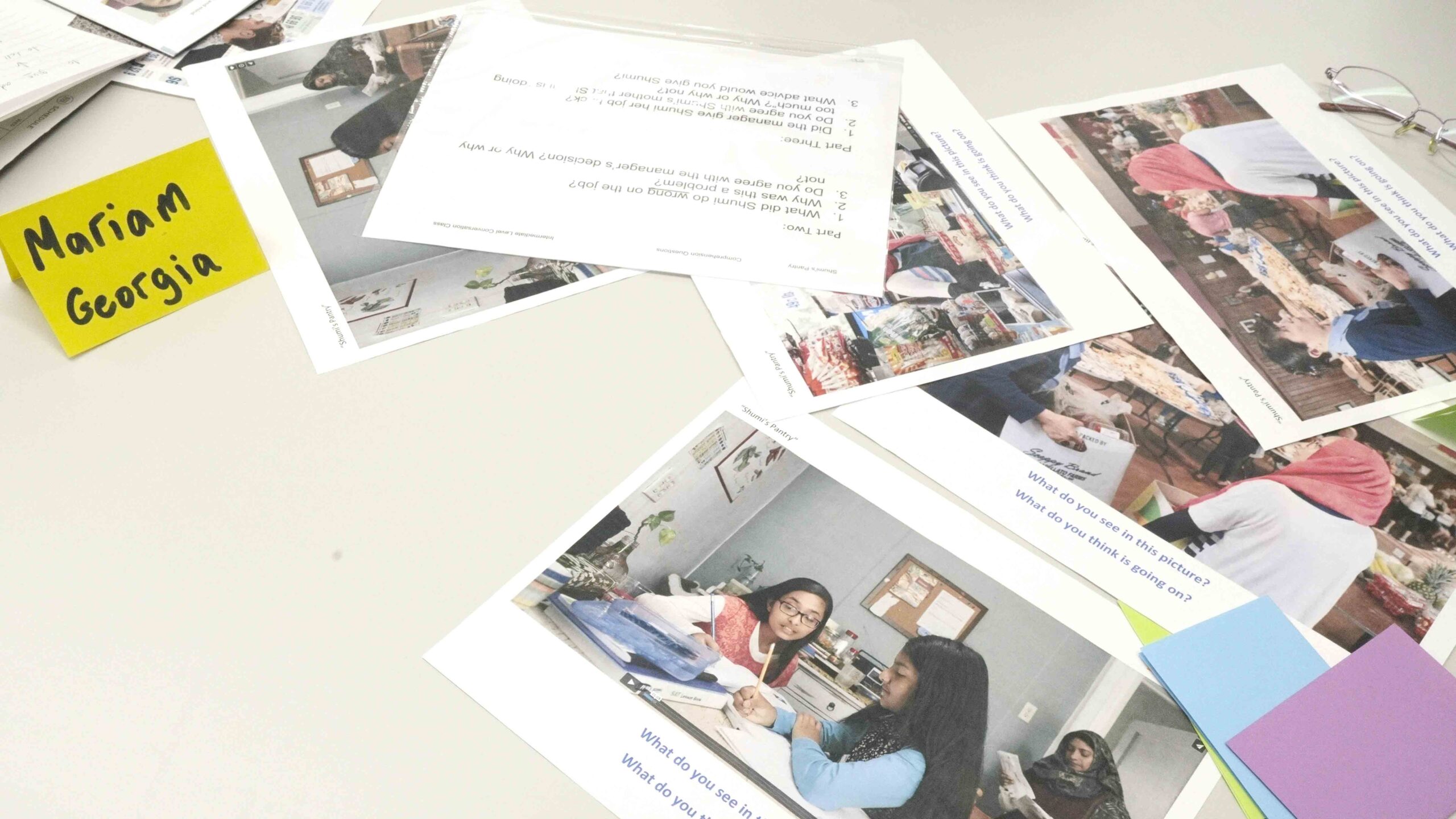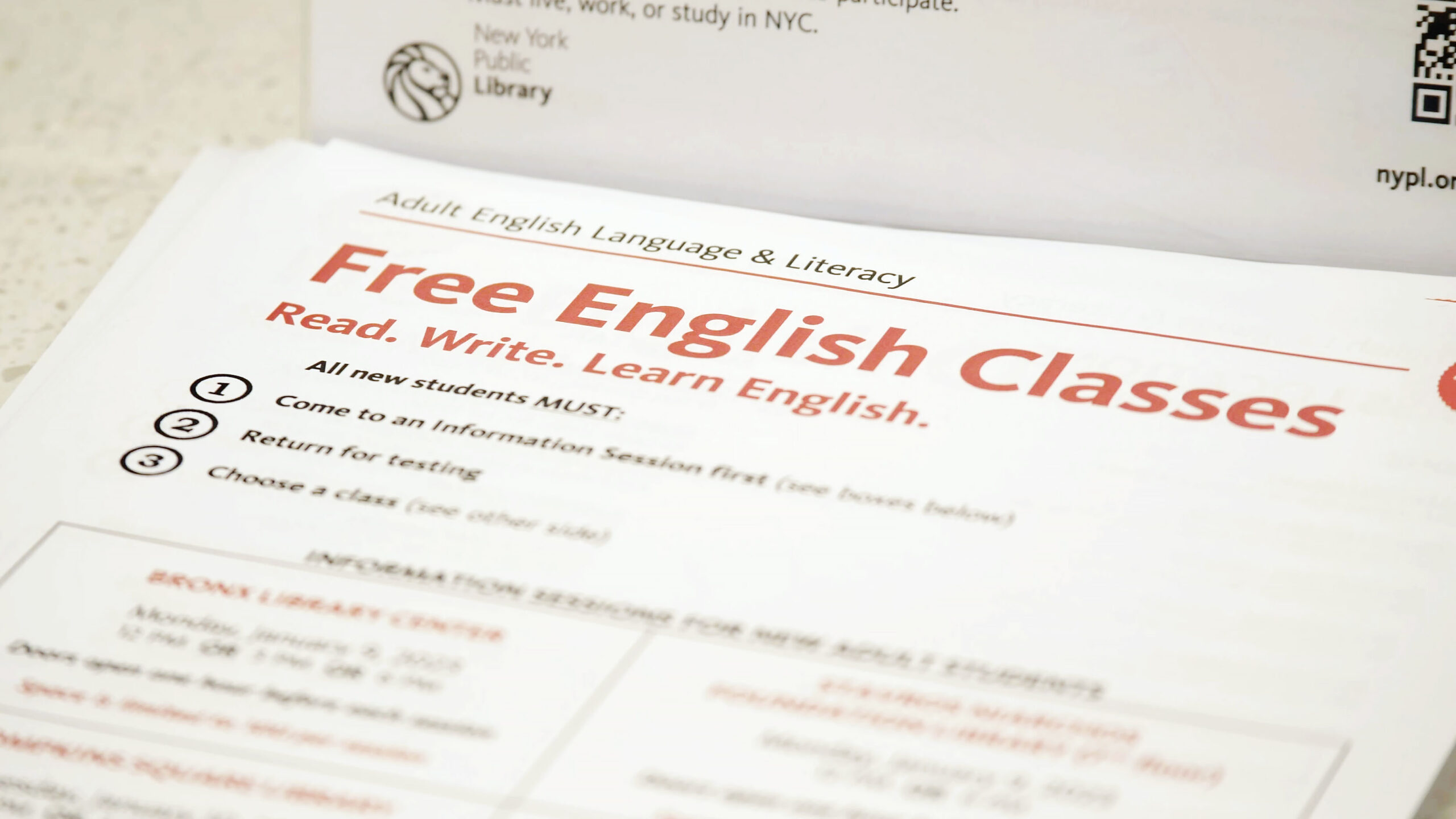From Cross-Country Borders to Language School
By Seyeon Bang
People cross the borders of the United States every day in pursuit of a dream. Some come to America for higher education, some for political freedom, and many others to escape war and conflict in their home countries. Many immigrants arrive in New York City in anticipation of living in a city of dreams. However, what awaits them is yet another obstacle: the language barrier.
Without the ability to speak English, finding a job, getting an education, or even making friends is incredibly challenging. To overcome this hurdle, many immigrants search for English learning centers.
New York City provides free English Language Learning programs to immigrants through a walk-in system at 11 public libraries across the five boroughs. Among them, Stavros Niarchos Foundation Library (SNFL) in Manhattan offers the largest number of classes, so its 6th floor is often filled with students who have come to improve their English skills.
One class at maximum capacity is Intermediate Conversation, which is mostly filled with students who have been in the U.S. for less than half a year.
Chinese and Spanish speakers often learn English by helping each other whenever unfamiliar words come up. Outside of these communal peer dynamics, Mariam Gurgenidze, 21, the only student from Georgia, struggles to keep up with the class, in which her only outside source of help is Google Translate.

A desk with Mariam’s name card.
Gurgenidze began taking the classes after her younger brother found out about them on social media.
“I come here three days a week and it’s great because it helps me overcome the language barrier and communicate with people,” Gurgenidze said.
Gurgenidze arrived in the United States in April. Her father and brother already live in New York City and she says she plans on studying education in college because completing the same major in Georgia pays less.
“When I first got here,” Gurgenidze continued, “it wasn’t too hard to settle down because I had family here. Also, because many people are in a similar situation as me, we often practice together and this helps us overcome difficulties in communication.”
The NYC Department of Youth & Community Development (DYCD) also allows immigrants to apply to education programs run by nonprofit organizations for speakers of other languages. People can search for them in their native tongue by borough, neighborhood, or zip code, and discoverDYCD provides contact information, activities offered, and a mapping feature with navigation.
A total of 87 programs are offered throughout the five boroughs, with 20 centers located in Manhattan. Beyond their reduced class sizes and spoken language practice, nonprofit language centers offer more classes with an organized syllabus on grammar and writing courses, compared to the on-request participation in the public library system.
Among them, the COPE Institute, the non-profit education branch of Agudath Israel of America, also assists immigrant students, especially those who have recently fled from the war. The classes are taught by teachers who also immigrated to the U.S. some time ago, so many of them are more empathetic towards the students.
Zoriana Murashka, 25, from Ukraine has been in the U.S. for two months and at the institute for two weeks. She says her teacher helps her not only to learn English but also integrate into the American way of life.

Zoriana Murashka taking an English class at COPE Institute.
“It’s exciting to learn about everything. I was happy that I was here when Americans celebrated Halloween and Thanksgiving Day,” laughed Murashka.
Having spent six years working as a journalist and magazine editor in Ukraine, she wishes to continue her career as a journalist after getting a firm grasp on English.
“I should decide whether I go into journalism or not. However, I need to become fluent in English first. Without English, it’s almost impossible to get a job here,” she added.
Under the Uniting for Ukraine program, Murashka holds a two-year permission visa. She is unsure what the U.S. government will decide after two years. Over the next two years, she plans to learn English and contribute to the recovery and renovation of Ukraine. She stressed that her country should not be remembered only for its tragic history.
“I have a lot of information about my country to share. It is my hope that my English skills will help me to convey the culture, tradition, and people of my country to audiences,” said Murashka.
Absalon Zuniga, 59, who immigrated to the U.S. from Ecuador 12 years ago, attends English classes twice a week at the COPE Institute. He recalled that he had to drive a truck from dawn to dusk every day when he arrived here in New York City.
Zuniga now works part-time at a food company and spends eight hours a day at JFK Airport three days a week. He said he finally has some free time, so this is his first time learning English in a classroom setting.
“The most important thing for me is to communicate well with my customers,” said Zuniga. “Also, I want to own a truck and work on my own after I retire in three years.”
Similar to Gurgenidze, Murashka, and Zuniga, most immigrants in New York City often begin their journey by searching for English centers. However, despite support from the government, the number of free English classes is not enough to meet the high demand.
There are only two English teachers at Stavros Niarchos Foundation Library (SNFL), and one of them has more than 25 students in one class. Since students are allowed to participate on-site without prior registration at the public library, there is a constant influx of students and extra chairs often have to be brought in to accommodate them. Some courses offered by nonprofit organizations even have a waitlist for classes.
Raizel Rusanov, the program director of COPE Institute, said the recent influx of immigrant students this year can be attributed in part to the Russia-Ukraine War, as well as borders reopening after the pandemic.
According to The New York Times, more than 22,000 immigrants have arrived in New York City since April.
“Last year, there was a lot of immigration that was at a standstill because the consulates were closed for the pandemic. So people could not physically come here,” Rusanov said. “Now consulates and embassies in other countries are giving visas again so immigrants come to the U.S.”

Flyers advertising free English classes at Stavros Niarchos Foundation Library (SNFL)
To make things a bit more complicated for such students, public libraries in New York City only provide foreign language flyers based on the population in their neighborhoods. Immigrants who live in too small a community will not be provided with flyers in their native language, leaving them out of the loop regarding important information for English classes. Although library branches can request flyers in a foreign language, this is unlikely to occur until a particular language group attends in large numbers.
Nevertheless, immigrants give and receive help in the community they belong to.
“Students find our institute through their friends. Some people are following other ethnic social groups on WhatsApp, on Telegram. They spread the word within their own ethnic group,” said Rusanov.
For many new immigrants in New York City, crossing the border is one major obstacle, but there are countless others they must overcome to settle into their new home.
“At this moment, I should find myself, find my way in the new country,” said Murashka. “But I put all my efforts toward studying English because it will be easier to find something.”
Some of the interviewees’ answers were translated from their native language to English.